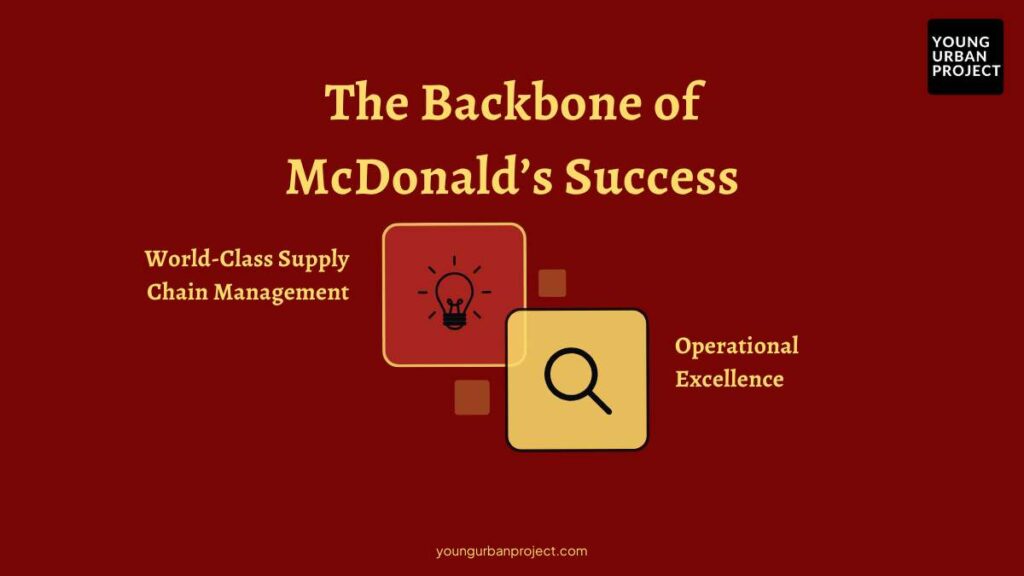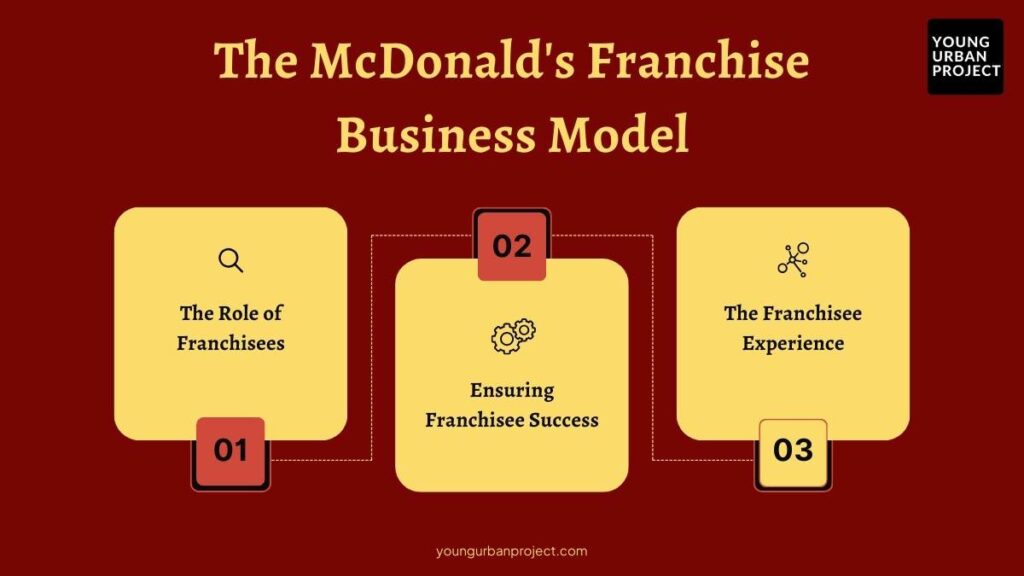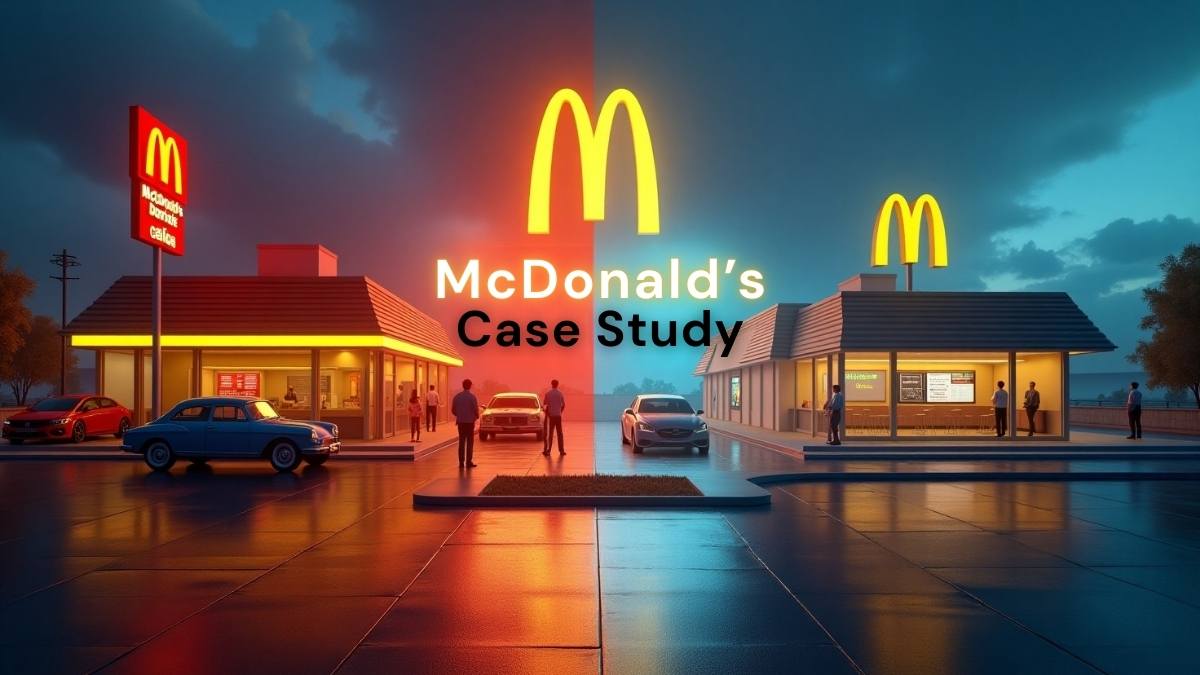When you think of fast food, McDonald’s probably pops into your head first. And that’s no accident.
Table of Contents
From its modest start, McDonald’s has exploded into one of the most recognized brands worldwide. Today, you’ll find those golden arches in over 120 countries, feeding more than 69 million people every day — that’s roughly 1% of the world grabbing a Big Mac or fries daily!
What began as a simple burger stand transformed into a global icon. But the real story isn’t just about burgers and fries – it’s about how they built an empire through brilliant marketing, insanely efficient operations, and constant innovation.
Let’s see how it all started in this detailed McDonald’s Case Study.
McDonald’s: The Startup Story – From a Small Town to a Global Brand
Humble Beginnings in California (1940)
Back in 1940, brothers Richard and Maurice McDonald opened their first restaurant in San Bernardino, California.
- It started as a small drive-in with a basic menu — burgers, fries, and shakes.
- They introduced the “Speedee Service System” — a revolutionary approach focused on speed and consistency.
Enter Ray Kroc (1954)
In 1954, Ray Kroc, a 52-year-old milkshake machine salesman, visited the McDonald brothers’ joint.
- He was blown away by their setup: quick, consistent, high-quality food.
- Kroc envisioned thousands of McDonald’s locations — not just one.
By 1961, Kroc bought the entire operation for $2.7 million — a fortune back then — and set out to build a global phenomenon.
Fun Fact:
The iconic Golden Arches? They started as part of the actual building design before evolving into the logo we all recognize today.
The McDonald’s Business Model: Revolutionizing the Fast-Food Industry
Franchising: The Secret to Explosive Growth
Instead of opening and running every restaurant themselves, McDonald’s went with franchising — a move that let individual entrepreneurs open locations under the McDonald’s brand.
Why the Franchise Model Works So Well:
- Consistency: A Quarter Pounder tastes the same in New York and New Delhi.
- Ownership with support: Franchisees run their own stores, but McDonald’s provides marketing, training, and operations help.
- Real estate game: McDonald’s often owns the land under franchise locations — making them a real estate powerhouse, not just a burger chain.
Competitive Edge
- Global brand power
- Speed and efficiency
- Affordable pricing that appeals to a wide range of consumers
Financial Performance
- Over $23 billion in revenue (2022) (Source)
- High profit margins thanks to the franchise model
- Steady dividends that attract and please investors
McDonald’s isn’t just selling burgers — it’s a money-making machine.
McDonald’s Marketing Strategies: The Secret Sauce Behind the Golden Arches
1. Branding and Advertising Mastery
McDonald’s has a marketing legacy that belongs in the hall of fame.
- Ronald McDonald, catchy slogans like “I’m Lovin’ It”, and emotional advertising campaigns
- The Golden Arches are more than a logo — they’re a universal symbol of comfort and familiarity
They’ve built deep emotional connections, especially with kids and families, to create lifelong customer loyalty.
2. Localizing the Global Brand
McDonald’s manages to feel both familiar and local around the world:
- India: McAloo Tikki
- Japan: Teriyaki Burgers
- Italy: Espresso and pasta salads
They adapt their menu and marketing based on regional preferences while maintaining core brand identity.
3. Digital Marketing and Social Media Dominance
In today’s world, McDonald’s is crushing it online too.
- Mobile apps packed with deals, points, and rewards
- Engaging social media content — funny, relatable, and on-trend
- Celebrity collaborations like the Travis Scott Meal — so popular they literally ran out of ingredients
They’re leaders in SEO, content marketing, and digital advertising, ensuring McDonald’s is always in your feed and search results.
Marketing Tip:
McDonald’s consistently promotes the experience, not just the food.
Also Read: Starbucks Case Study: Marketing Strategy & Growth
Supply Chain and Operational Efficiency: The Backbone of McDonald’s Success

1. World-Class Supply Chain Management
McDonald’s success hinges on a tight, reliable supply chain.
- Strict standards for beef, potatoes, lettuce — everything must match exact specs
- Long-term relationships with suppliers, often helping them grow
- The “Three-Legged Stool” philosophy — company, suppliers, and franchisees all working together to stay aligned
2. Operational Excellence
Step into any McDonald’s and you’ll see systems designed for speed, efficiency, and consistency.
- Kitchen layouts engineered for fast assembly
- Training programs, including Hamburger University, to ensure every manager knows the playbook
- Customer service focused on quick, friendly, and accurate delivery
Also Read: Netflix Case Study: Marketing Strategies and Tactics
Sustainability in the Fast-Food Industry: McDonald’s Approach
Alright, let’s be real for a second — fast food and sustainability haven’t exactly been best friends historically.
But McDonald’s? They’ve been making serious moves to change that narrative.
Challenges and Solutions
McDonald’s faces major challenges around:
- Greenhouse gas emissions (especially from beef production)
- Packaging waste (all those wrappers and containers)
- Water and energy usage (across thousands of restaurants)
Instead of just brushing it off, McDonald’s started addressing these issues head-on. They committed to sourcing 100% of their guest packaging from renewable, recycled, or certified sources by 2025.
They’re also working toward cutting greenhouse gas emissions by 36% by 2030 compared to 2015 levels. Of course, critics argue that there’s still a long way to go (and they’re not wrong).
But compared to most competitors, McDonald’s efforts are… impressive, if not perfect.
Sustainability Initiatives
- Happy Meals revamp: Smaller portions, healthier sides like apple slices.
- Sustainable beef pilot programs in countries like Canada.
- Renewable energy: Installing solar panels in select locations.
- Plant-based options: Launching the McPlant burger in collaboration with Beyond Meat.
Side Note:
Honestly, it’s refreshing to see a giant like McDonald’s acknowledging the problem instead of pretending it doesn’t exist.
Also Read: 15 Green Marketing Examples
Future Goals
By 2050, McDonald’s aims to reach net-zero emissions across its operations.
Bold? For sure.
Achievable? Maybe.
Necessary? Absolutely.
McDonald’s Innovations: Beyond Burgers and Fries
If you think McDonald’s is just about burgers and fries… well, you’re kind of missing the bigger picture.
They’ve been quietly reinventing themselves in ways most people don’t even notice.
1. Product Innovations
- Healthier Menus: Salads, fruit, oatmeals — it’s not all just burgers anymore.
- Localized Menus: In Hong Kong, you can get Rice Burgers. In India, no beef at all — everything adapted for local tastes and religions.
They’re not stubborn about tradition. They’re flexible — and that’s why they keep winning.
2. Technology Innovations
- Self-service kiosks: Cutting wait times and boosting upselling.
- Mobile ordering: Letting customers order and pay in advance through the app.
- AI-driven personalization: After acquiring Dynamic Yield for $300 million, McDonald’s started customizing drive-thru menus based on weather, traffic, and even time of day. Crazy futuristic, right?
3. Digital Transformation
Everything — from kitchen ops to customer loyalty programs — is being digitized.
This “McDigital” approach improves:
- Speed
- Efficiency
- Customer satisfaction
The future of McDonald’s probably looks a lot more like an app… and a little less like a greasy drive-thru.
The McDonald’s Franchise Business Model: A Blueprint for Success
If you’re an entrepreneur (or even just business-curious), this is the section you’ll want to lean into.

1. The Role of Franchisees
Today, roughly 93% of McDonald’s restaurants are franchised (Source). Franchisees aren’t just “store managers” — they are full-fledged business owners.
They invest their own money, but they also get McDonald’s brand power, systems, and marketing support in return.
It’s a partnership:
- McDonald’s handles national branding and innovation.
- Franchisees handle local execution and community involvement.
2. Ensuring Franchisee Success
McDonald’s doesn’t just hand over the keys and say, “Good luck!”
They provide:
- Extensive training at Hamburger University
- Operational support
- Marketing campaigns
- New technology rollouts
Franchisees also get access to regional management teams for guidance and troubleshooting.
3. The Franchisee Experience
It’s not all sunshine — some franchisees have clashed with corporate over rent increases or new policies.
But overall, franchisees have helped McDonald’s scale globally faster than almost any other brand.
It’s honestly a masterclass in how to balance brand control with entrepreneurial freedom.
The Future of McDonald’s: Reinventing the Golden Arches
McDonald’s isn’t just sitting around enjoying past glory — they know the landscape is shifting fast.
1. Strategic Outlook
They’re doubling down on:
- Drive-thru innovation (AI-powered lanes)
- Sustainability efforts
- Digital loyalty programs to keep customers coming back
- Plant-based foods as consumer tastes evolve
They also understand that brand trust is the currency of the future — and they’re investing heavily in customer experience.
2. Embracing New Markets
Emerging economies like India, China, and Africa are huge opportunities.
McDonald’s is adapting their menu, pricing, and store formats (think smaller, more efficient stores) to penetrate these markets without losing that classic McDonald’s flavor.
Also Read: Amul Case Study
The Takeaway: Key Lessons from McDonald’s Business Success
Alright, let’s wrap this up with the juicy stuff you can actually apply.
Key Lessons for Entrepreneurs
- Scale smart, not fast: McDonald’s scaled through franchising without losing control.
- Consistency is king: Whether it’s the fries or the logo, never compromise your core experience.
- Local relevance matters: Customize for local tastes without diluting your brand.
- Innovate or die: Tech and menu innovations kept McDonald’s ahead of the curve.
Insights for Digital Marketers
- Build emotional branding (like Ronald McDonald did)
- Own omnichannel marketing (online, offline, everywhere)
- Invest in loyalty — repeat customers are gold.
If you dream of scaling a brand, nailing digital marketing, or dominating your niche, McDonald’s should be on your study list.

Enroll Now: Live Advanced Digital Marketing Course
Conclusion
From a tiny burger joint in San Bernardino to a global marketing and business case study, McDonald’s journey is nothing short of remarkable.
They didn’t just master the fast-food game — they rewrote the rules of franchising, branding, and operational excellence. And now, by leaning into tech innovation and sustainability, they’re ensuring that the Golden Arches will shine for generations to come.
For digital marketers, entrepreneurs, and brand builders alike, McDonald’s story is loaded with timeless lessons about resilience, reinvention, and relentless customer focus.
And who knows? The next “Golden Arches” might just come from you.
FAQs: McDonald’s Case Study
1. How much does a McDonald’s franchise owner make?
It varies, but after expenses, many McDonald’s franchise owners in the U.S. report annual earnings between $150,000 and $250,000. Actual income depends heavily on location, sales volume, and operational efficiency. Some owners in high-traffic areas may earn more, while others may earn less.
2. What is McDonald’s digital marketing strategy?
It blends global campaigns with local targeting, leveraging mobile apps, loyalty programs, social media, influencer collaborations, and SEO optimization.
3. How did Ray Kroc transform McDonald’s into a global brand?
Ray Kroc expanded aggressively through franchising, ensured operational consistency, and standardized branding across all locations.
4. How does McDonald’s use digital marketing to maintain global brand recognition?
Through personalized mobile apps, social media engagement, dynamic paid ads, and global loyalty programs like MyMcDonald’s Rewards.
5. What innovations has McDonald’s introduced in its menu and technology?
Menu innovations include McPlant burgers and localized dishes; tech innovations include self-order kiosks, mobile ordering, and AI-driven menu boards.
6. What sustainability initiatives is McDonald’s focusing on?
Renewable energy use, sustainable beef sourcing, waste reduction in packaging, and a goal to reach Net Zero emissions by 2050.

